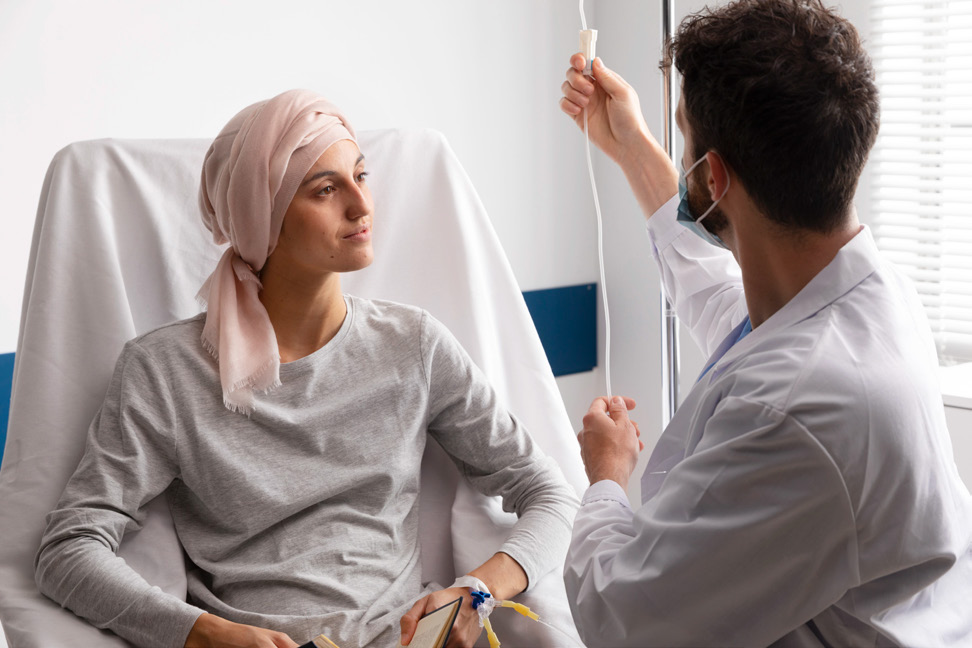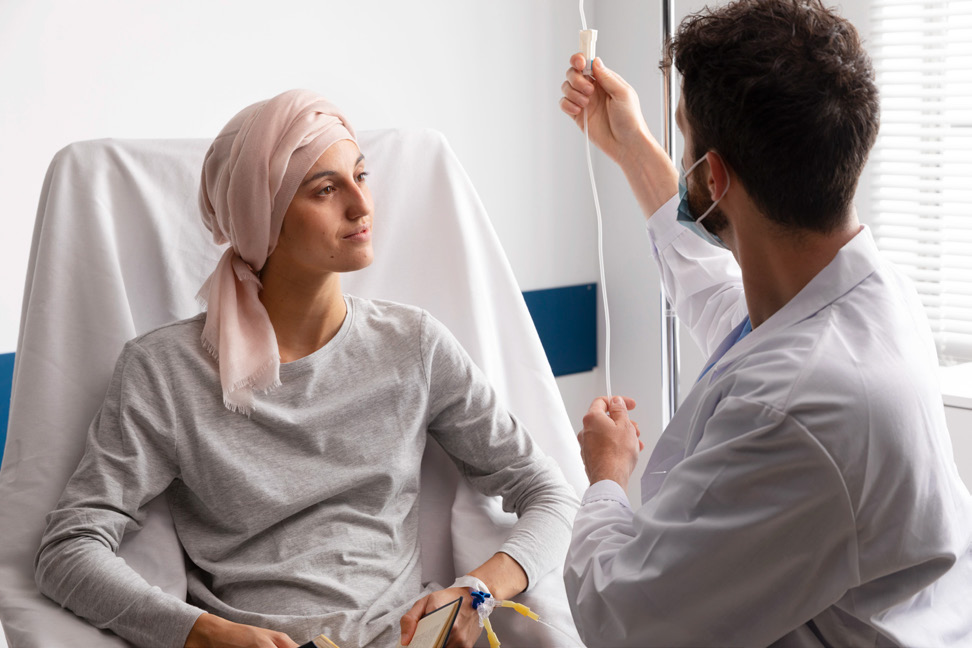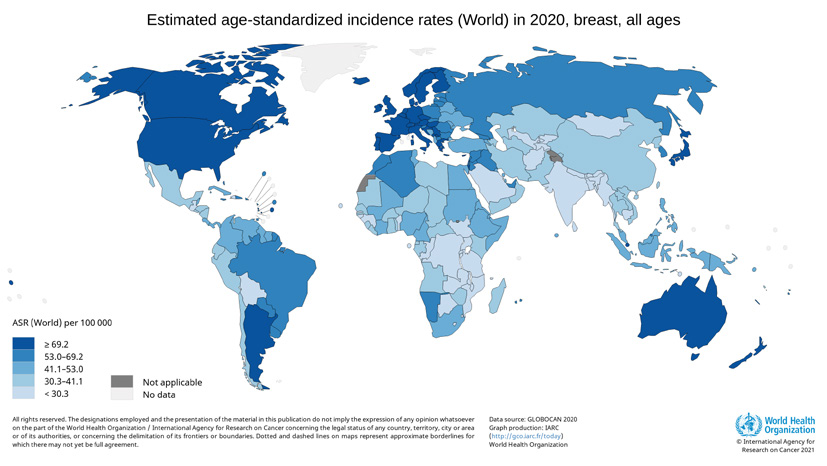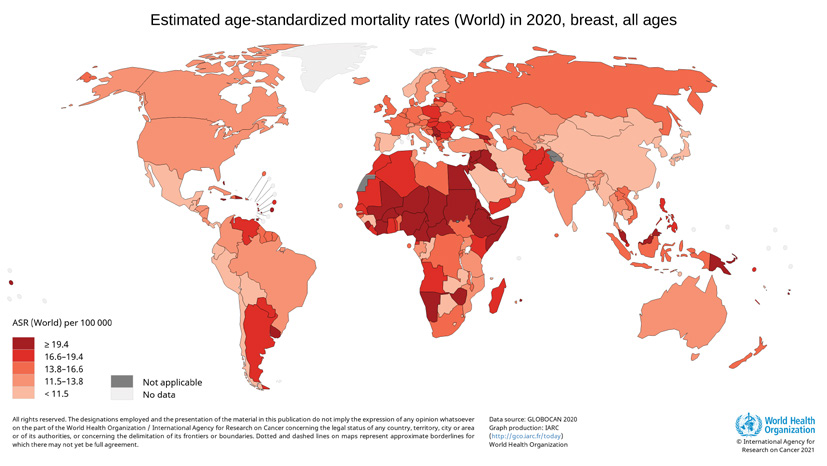







































































































GLOBAL
BREAST
CANCER
THERAPEUTICS MARKET
ANALYSIS, 2022-2030




















Global Breast Cancer Therapeutics Market Analysis, 2022-2030
CONTENTS
1. Overview
03
2. Prevalence of Breast Cancer in the World
04
3. Types of Breast Cancer
08
4. Drugs Approved for Breast Cancer
12
5. Market Size and Key Findings
15
6. Regional Analysis
16
7. Market Dynamics
20
8. Competitive Landscape
21
9. Healthcare Policy and Regulatory Landscape
22
10. Reimbursement Scenario
23
11. Latest Trends and Innovations
24
12. Conclusion
25
Global Breast Cancer Therapeutics Market Analysis, 2022-2030
Overview
The Global Breast Cancer Therapeutics Market is projected to grow from $18.2 Bn in 2022 to $48.0 Bn by 2030, registering a CAGR of 12.9% during the forecast period of 2022 - 2030.
Breast cancer is the second most common cancer in women worldwide, after skin cancer. The global breast cancer therapeutics market is a rapidly growing market and is expected to continue to grow in the coming years.
The market for breast cancer therapeutics is driven by a number of factors, including the increasing prevalence of breast cancer, the development of new and innovative drugs, and the growing demand for personalized medicine. The market is also benefiting from several initiatives and campaigns to raise awareness about breast cancer and the importance of early detection and treatment.
Some of the key players in the breast cancer therapeutics market include AstraZeneca, Roche, Pfizer, Novartis, and Eli Lilly. These companies are investing heavily in research and development to develop new treatments and improve existing ones. They are also working to improve patient access to breast cancer treatments by expanding their distribution networks and working with healthcare providers to improve diagnosis and treatment.
The breast cancer therapeutics market is segmented by type of therapy, including chemotherapy, targeted therapy, hormonal therapy, and others. The market is also segmented by types, distribution channels and regions.
Overall, the global breast cancer therapeutics market is expected to continue to grow at a rapid pace in the coming years, driven by increasing demand for effective treatments and ongoing investment in research and development.
Global Breast Cancer Therapeutics Market (in $ Bn) Matket is forecast to grow at a CAGR of 12.9%
48.0
42.6
37.7
33.4
29.8
26.2
23.2
20.5
18.2
2022
2023F
2024F
2025F
2026F
2027F
2028F
2029F
2023F
03

Global Breast Cancer Therapeutics Market Analysis, 2022-2030
What is the Prevalence of
Breast Cancer in the World?
With 1 in 8 cancer diagnoses worldwide, breast cancer is the most frequently diagnosed cancer kind. Each year, there are more than 2.3 Mn new instances of breast cancer in the world, and there were also approximately 685,000 deaths from this illness, with significant regional variances between different nations and global areas.
Breast cancer is the primary or secondary cause of mortality for women from cancer in 95% of the world's nations. However, there are significant disparities in breast cancer survival between and within nations. Nearly 80% of breast and cervical cancer fatalities take place in low- and middle-income nations.
The most significant risk factor is age, and the oldest females have the highest age-specific incidence rates. Less than one in five women with breast cancer is diagnosed before the age of 50 in the UK, while more than one-third of cases affect women beyond the age of 70. In contrast, more than half of breast cancer cases in women under 50 years old occur in less developed nations.
These disparities in breast cancer incidence and survival are likely due to a number of factors, including access to healthcare, screening programs, and awareness of the signs and symptoms of breast cancer. In many low- and middle-income countries, women do not have regular access to healthcare, and screening programs for breast cancer are not widely available. As a result, breast cancer is often diagnosed at a later stage, when it is more difficult to treat and less likely to be cured.
04
Global Breast Cancer Therapeutics Market Analysis, 2022-2030
Estimated new cancer cases and deaths by sex, US, 2023
Estimated New Cases
Estimated Deaths
Cancer Site
Both Sexes
Male
Female Both Sexes
Male
Female
All sites
1,958,310 1,010,310 948,000
609,820
322,080
287,740
Breast
300,590
2800
297,790
43,700
530
43,170
Oral cavity & pharynx
54,540
39,290
15,250
11,580
8140
3440
Tongue
18,040
13,180
4860
2940
1950
990
Mouth
14,820
8680
6140
3090
1870
1220
Pharynx
20,070
16,340
3730
4140
3260
880
Other oral cavity
1610
1090
520
1410
1060
350
Digestive system
348,840
194,980
153,860
172,010
99,350
72,660
Esophagus
21,560
17,030
4530
16,120
12,920
3200
Stomach
26,500
15,930
10,570
11,130
6690
4440
Small intestine
12,070
6580
5490
2070
1170
900
Colon & rectum
153,020
81,860
71,160
52,550
28,470
24,080
Colon
106,970
54,420
52,550
0
0
0
Rectum
46,050
27,440
18,610
0
0
0
Anus, anal canal, & anorectum
9760
3180
6580
1870
860
1010
Liver & intrahepatic bile duct
41,210
27,980
13,230
29,380
19,000
10,380
Gallbladder & other biliary
12,220
5750
6470
4510
1900
2610
Pancreas
64,050
33,130
30,920
50,550
26,620
23,930
Other digestive organs
8450
3540
4910
3830
1720
2110
Respiratory system
256,290
131,150
125,140
132,330
71,170
61,160
Larynx
12,380
9900
2480
3820
3070
750
Lung & bronchus
238,340
117,550
120,790
127,070
67,160
59,910
Other respiratory organs
5570
3700
1870
1440
940
500
Bones & joints
3970
2160
1810
2140
1200
940
Soft tissue (including heart)
13,400
7400
6000
5140
2720
2420
Skin (excluding basal & squamous)
104,930
62,810
42,120
12,470
8480
3990
Melanoma of the skin
97,610
58,120
39,490
7990
5420
2570
Other nonepithelial skin
7320
4690
2630
4480
3060
1420
Genital system
414,350
299,540
114,810
69,660
35,640
34,020
05
Global Breast Cancer Therapeutics Market Analysis, 2022-2030
Uterine cervix
13,960
0
13,960
4310
0
4310
Uterine corpus
66,200
0
66,200
13,030
0
13,030
Ovary
19,710
0
19,710
13,270
0
13,270
Vulva
6470
0
6470
1670
0
1670
Vagina & other female genital
8470
0
8470
1740
0
1740
Prostate
288,300
288,300
0
34,700
34,700
0
Testis
9190
9190
0
470
470
0
Penis & other male genital
2050
2050
0
470
470
0
Urinary system
168,560
117,590
50,970
32,590
22,680
9910
Urinary bladder
82,290
62,420
19,870
16,710
12,160
4550
Kidney & renal pelvis
81,800
52,360
29,440
14,890
9920
4970
Ureter & other urinary organs
4470
2810
1660
990
600
390
Eye & orbit
3490
1900
1590
430
240
190
Brain & other nervous system
24,810
14,280
10,530
18,990
11,020
7970
Endocrine system
47,230
14,340
32,890
3240
1560
1680
Thyroid
43,720
12,540
31,180
2120
970
1150
Other endocrine
3510
1800
1710
1120
590
530
Lymphoma
89,380
49,730
39,650
21,080
12,320
8760
Hodgkin lymphoma
8830
4850
3980
900
540
360
Non‐Hodgkin lymphoma
80,550
44,880
35,670
20,180
11,780
8400
Myeloma
35,730
19,860
15,870
12,590
7000
5590
Leukemia
59,610
35,670
23,940
23,710
13,900
9810
Acute lymphocytic leukemia
6540
3660
2880
1390
700
690
Chronic lymphocytic leukemia
18,740
12,130
6610
4490
2830
1660
Acute myeloid leukemia
20,380
11,410
8970
11,310
6440
4870
Chronic myeloid leukemia
8930
5190
3740
1310
780
530
Other leukemia
5020
3280
1740
5210
3150
2060
Other & unspecified primary sites
32,590
16,810
15,780
48,160
26,130
22,030
06
Global Breast Cancer Therapeutics Market Analysis, 2022-2030
Depicts The Most Common Cancers Diagnosed in Men & Women In 2023
Estimated New Cases
Prostate
288,300
29%
Males
Females
Breast
297,790
31%
Lung & bronchus
117,550
12%
Lung & bronchus
120,790
13%
Colon & rectum
81,860
8%
Colon & rectum
71,160
8%
Urinary bladder
62,420
6%
Uterine corpus
66,200
7%
Melanoma of the skin
58,120
6%
Melanoma of the skin
39,490
4%
Kidney & renal pelvis
52,360
5%
Non-Hodgkin hymphoma
35,670
4%
Non-Godgkin lymphoma
44,880
4%
Thyroid
31,180
3%
Oral cavity & pharynx
39,290
4%
Pancreas
30,920
3%
Leukemia
35,670
4%
Kidney & renal pelvis
29,440
3%
Pancreas
33,130
3%
Leukemia
23,940
3%
All sites
1,010,310
100%
All Sites
948,000
100%
Estimated Deaths
Lung & bronchus
67,160
21%
Males
Females
Prostate
Lung & bronchus
34,700
59,910
21%
11%
Colon & rectum
Breast
28,470
43,170
15%
9%
Pancreas
Colon & rectum
26,620
24,080
8%
8%
Liver & intrahepatic bile duct
Pancreas
19,000
23,930
8%
6%
Leukemia
Ovary
13,900
13,270
5%
4%
Esophagus
Uterine corpus
12,920
13,030
5%
4%
Urinary bladder
Liver & intrahepatic bile duct
12,160
10,380
4%
4%
Non-Hodgkin lymphoma
Leukemia
11,780
9,810
3%
4%
Brain & other nervous system
Non-Hodgkin lymphoma
11,020
8,400
3%
3%
All sites
Brain & other nervous system
322,080
7,970
3%
100%
All sites
287,740
100%
Nearly half (48%) of all incident instances of cancer in males are for the prostate, lung and bronchus (hereafter lung), and colorectal cancers (CRCs), with 29% of diagnoses coming from prostate cancer alone.
Breast cancer alone accounts for 31% of all cancer diagnoses in women, whereas lung cancer, CRC, and breast cancer together account for 52% of all new diagnoses.
07

Global Breast Cancer Therapeutics Market Analysis, 2022-2030
Types of
Breast Cancer?
There are several types of breast cancer, which are characterized based on the specific cells and tissues where the cancerous growth originates. The most common types of breast cancer are: Invasive Ductal Carcinoma (IDC)
Ductal Carcinoma in Situ (DCIS)
Invasive Lobular Carcinoma (ILC)
Triple-negative Breast Cancer (TNBC)
Metastatic Breast Cancer
Tubular Breast Cancer
Mucinous Breast Cancer
Inflammatory Breast Cancer (IBC)
Medullary Breast Cancer
08
Global Breast Cancer Therapeutics Market Analysis, 2022-2030
Ductal Carcinoma in Situ (DCIS):
DCIS is a non-invasive form of breast cancer that develops in the milk ducts of the breast. It is considered a pre-cancerous condition, as the abnormal cells are confined to the ducts and have not spread to nearby tissue.
In the US now, DCIS accounts for 20% to 25% of breast cancer diagnoses. This has increased along with the introduction of screening mammography because a sizable portion of DCIS is initially discovered on screening mammography. DCIS made up fewer than 5% of newly diagnosed breast cancers during the pre-screening mammography period.
Treatments available for Ductal Carcinoma in Situ (DCIS):
▪ Breast-conserving surgery (BCS)
▪ Mastectomy
▪ Hormone therapy after breast surgery
Distribution of new DCIS type breast cancer cases in the US
BY age group
20-34 Years
34-44 Years
45-54 Years
54-64 Years
64-74 Years
75-84 Years
85 Years & older
1%
10%
28%
27%
21%
11%
2%
Invasive Ductal Carcinoma (IDC):
IDC is the most common type of breast cancer, accounting for approximately 80% of all cases. It begins in the milk ducts of the breast but then invades the surrounding breast tissue.
Treatment for invasive ductal carcinoma
Invasive ductal carcinoma may be treated with:
▪
Surgery:
▪
Hormonal Therapy
▪
Radiation Therapy:
▪
Targeted Therapy
▪
Chemotherapy:
▪
Immunotherapy
09
Global Breast Cancer Therapeutics Market Analysis, 2022-2030
Estimated New Invasive Breast Cancer Cases among Women by Age, US, 2019
Age
Numbers
%
<40
11,870
4
40-49
37,150
14
50-59
61,560
23
60-69
74,820
28
70-79
52,810
20
79<
30,390
11
Invasive Lobular Carcinoma (ILC):
ILC originates in the lobules of the breast, which produce milk. It is less common than IDC, accounting for about 10-15% of all breast cancers. Treatment options may include surgery, radiation therapy, chemotherapy, and hormonal therapy.
Inflammatory Breast Cancer (IBC):
IBC is a rare and aggressive form of breast cancer that typically presents as a red, swollen, and warm breast. It occurs when cancer cells block the lymphatic vessels in the skin of the breast. Treatment for IBC usually involves a combination of different therapies, including Chemotherapy, Surgery, Radiation therapy, Targeted therapy, and Hormone therapy.
Triple-negative Breast Cancer (TNBC):
TNBC is a type of breast cancer that tests negative for estrogen receptors, progesterone receptors, and HER2/neu.
This means that the cancer does not respond to hormonal therapy or targeted therapies that are effective for other types of breast cancer. Treatment options may include surgery, radiation therapy, chemotherapy, and targeted therapy.
Lobular Carcinoma in Situ (LCIS):
When abnormal cells are discovered in the breast lobules, it is known as lobular carcinoma in situ (LCIS). The breast tissue around the lobules is not affected by the atypical cells.
Metastatic Breast Cancer:
Stage 4 breast cancer sometimes refers to metastatic breast cancer. Other body parts are now affected by the malignancy. Usually, the liver, bones, brain, and lungs are included in this.
10













Global Breast Cancer Therapeutics Market Analysis, 2022-2030
There are other types that are less commonly seen-Medullary Carcinoma:
Medullary carcinoma accounts for 3-5% of all breast cancer types. While the tumour frequently appears on mammography, it is not always felt as a bump. It can occasionally resemble a spongy breast tissue alteration.
Tubular Carcinoma:
Tubular carcinoma cells, which account for around 2% of all breast cancer diagnoses, have a recognisable tubular form. A clump of cells that can feel more like a spongy patch of breast tissue than a lump is typically discovered by a mammography. This particular kind of breast cancer typically affects women over the age of 50 and responds favourably to hormone therapy.
Mucinous Carcinoma (Colloid):
A percentage of breast tumours between 1% and 2% is mucinous carcinomas. Mucus production and poorly defined cells are the major characteristics that set them apart from one another. It typically has a good prognosis as well.
Paget Disease of The Breast or Nipple:
A uncommon kind of cancer, breast Paget disease affects the skin of the nipple and frequently the areola, the darker circle of skin surrounding the nipple. Most persons with Paget disease that is visible on the nipple also have one or more tumours inside the same breast, which are often either invasive breast cancer or ductal carcinoma in situ (1–3). The initial signs of Paget illness are usually misdiagnosed because they are easily mistaken for more wide-spread skin disorders that affect the nipple. The prognosis for Paget disease, like all breast cancers, depends on a number of variables, such as the existence or absence of invasive malignancy and whether or not it has spread to neighbouring lymph nodes.
11






Global Breast Cancer Therapeutics Market Analysis, 2022-2030
What are the treatment options
for Breast Cancer?
The treatment of breast cancer has made remarkable strides in recent years, offering a beacon of hope to those affected by this pervasive disease. Breast cancer treatment is not a one-size-fits-all approach but rather a finely tuned orchestra of therapies tailored to the specific type, stage, and individual characteristics of the cancer. From surgical procedures designed to remove or reshape affected breast tissue to targeted therapies aimed at disrupt-ing the molecular mechanisms of cancer growth, the landscape of breast cancer treatment is as diverse as it is dynamic.
This comprehensive approach encompasses the traditional pillars of surgery, chemotherapy, and radiation therapy, as well as the latest innovations in immunotherapy and precision medicine. With a better understanding of these multifaceted treatment options, patients and healthcare providers alike can navigate the complex journey towards defeating breast cancer with increased confidence and optimism.
Drugs Approved to Prevent Breast Cancer
▪
Evista (Raloxifene Hydrochloride)
▪
Soltamox (Tamoxifen Citrate)
▪
Raloxifene Hydrochloride
▪
Tamoxifen Citrate
12
Global Breast Cancer Therapeutics Market Analysis, 2022-2030
Drugs Approved to Treat Breast Cancer
▪
Abemaciclib
▪
Letrozole
▪
Abraxane (Paclitaxel Albumin-stabilized
▪
Lynparza (Olaparib)
Nanoparticle Formulation)
▪
Margenza (Margetuximab-cmkb)
▪
Ado-Trastuzumab Emtansine
▪
Margetuximab-cmkb
▪
Afinitor (Everolimus)
▪
Megestrol Acetate
▪
Afinitor Disperz (Everolimus)
▪
Methotrexate Sodium
▪
Alpelisib
▪
Neratinib Maleate
▪
Anastrozole
▪
Nerlynx (Neratinib Maleate)
▪
Aredia (Pamidronate Disodium)
▪
Olaparib
▪
Arimidex (Anastrozole)
▪
Orserdu (Elacestrant Dihydrochloride)
▪
Aromasin (Exemestane)
▪
Paclitaxel
▪
Capecitabine
▪
Paclitaxel Albumin-stabilized Nanoparticle
▪
Cyclophosphamide
Formulation
▪
Docetaxel
▪
Palbociclib
▪
Doxorubicin Hydrochloride
▪
Pamidronate Disodium
▪
Elacestrant Dihydrochloride
▪
Pembrolizumab
▪
Ellence (Epirubicin Hydrochloride)
▪
Perjeta (Pertuzumab)
▪
Enhertu (Fam-Trastuzumab Deruxtecan-nx-
▪
Pertuzumab
ki)
▪
Pertuzumab, Trastuzumab, and Hyaluroni-
▪
Epirubicin Hydrochloride
dase-zzxf
▪
Eribulin Mesylate
▪
Phesgo (Pertuzumab, Trastuzumab, and
▪
Everolimus
Hyaluronidase-zzxf)
▪
Exemestane
▪
Piqray (Alpelisib)
▪
5-FU (Fluorouracil Injection)
▪
Ribociclib
▪
Fam-Trastuzumab Deruxtecan-nxki
▪
Sacituzumab Govitecan-hziy
▪
Fareston (Toremifene)
▪
Soltamox (Tamoxifen Citrate)
▪
Faslodex (Fulvestrant)
▪
Talazoparib Tosylate
▪
Femara (Letrozole)
▪
Talzenna (Talazoparib Tosylate)
▪
Fluorouracil Injection
▪
Tamoxifen Citrate
▪
Fulvestrant
▪
Taxotere (Docetaxel)
▪
Gemcitabine Hydrochloride
▪
Tecentriq (Atezolizumab)
▪
Gemzar (Gemcitabine Hydrochloride)
▪
Tepadina (Thiotepa)
▪
Goserelin Acetate
▪
Thiotepa
▪
Halaven (Eribulin Mesylate)
▪
Toremifene
▪
Herceptin Hylecta (Trastuzumab and
▪
Trastuzumab
Hyaluronidase-oysk)
▪
Trastuzumab and Hyaluronidase-oysk
▪
Herceptin (Trastuzumab)
▪
Trexall (Methotrexate Sodium)
▪
Ibrance (Palbociclib)
▪
Trodelvy (Sacituzumab Govitecan-hziy)
▪
Infugem (Gemcitabine Hydrochloride)
▪
Tucatinib
▪
Ixabepilone
▪
Tukysa (Tucatinib)
▪
Ixempra (Ixabepilone)
▪
Tykerb (Lapatinib Ditosylate)
▪
Kadcyla (Ado-Trastuzumab Emtansine)
▪
Verzenio (Abemaciclib)
▪
Keytruda (Pembrolizumab)
▪
Vinblastine Sulfate
▪
Kisqali (Ribociclib)
▪
Xeloda (Capecitabine)
▪
Lapatinib Ditosylate
▪
Zoladex (Goserelin Acetate)
13

Global Breast Cancer Therapeutics Market Analysis, 2022-2030
Drug Combinations Used in Breast Cancer
▪
AC
▪
CMF
▪
AC-T
▪
FEC
▪
CAF
▪
TAC
Below is a summary of some of the drugs commonly used to treat breast cancer:
▪
Hormone therapy: This type of therapy is used for hormone receptor-positive breast cancers and includes drugs that block the effects of estrogen on the cancer cells. Examples of hormone therapy drugs include tamox-ifen, aromatase inhibitors (such as letrozole, anastrozole, and exemestane), and fulvestrant.
▪
Chemotherapy: Chemotherapy is a systemic treatment that can be used to treat various types and stages of breast cancer. Examples of chemotherapy drugs used to treat breast cancer include taxanes (such as paclitaxel and docetaxel), anthracyclines (such as doxorubicin and epirubicin), and cyclophosphamide.
▪
Targeted therapy: Targeted therapy drugs are designed to attack specific proteins or genes in cancer cells.
Examples of targeted therapy drugs used to treat breast cancer include trastuzumab, pertuzumab, lapatinib, neratinib, and everolimus.
▪
Immunotherapy: Immunotherapy drugs work by stimulating the body's immune system to recognize and attack cancer cells. For breast cancer, the immunotherapy drug atezolizumab is sometimes used in combination with chemotherapy for triple-negative breast cancer that is PD-L1 positive.
▪
PARP inhibitors: PARP inhibitors are a type of targeted therapy drug that work by blocking an enzyme involved in DNA repair. These drugs are used to treat BRCA-mutated breast cancer and include olaparib, talazoparib, and rucaparib.
▪
Bisphosphonates and denosumab: These drugs are used to help prevent bone loss and reduce the risk of bone metastases in breast cancer patients. Examples of bisphosphonates include zoledronic acid and pamid-ronate, while denosumab is a monoclonal antibody.
14



Global Breast Cancer Therapeutics Market Analysis, 2022-2030
How big is the market for breast
cancer treatments, & what
are the key trends?
Market Size and Key Findings
Breast Cancer Therapeutics
Market Size, By Region
(in $ Bn)
3.822
9.1
3.458
APAC
Europe
Middle East
Africa
Latin America
North America
0.728
0.273
0.819
The data presented is tentative & subject to change in the final report.
15
Global Breast Cancer Therapeutics Market Analysis, 2022-2030
Regional Analysis
The Global Breast Cancer Therapeutics Market is categorized into five regions based on geography: North America, Europe, Asia Pacific, Latin America, and the Middle East & Africa. North America accounted for the largest share of the global breast cancer drugs market in 2022 and is expected to remain dominant during the forecast period. This growth can be attributed to the presence of well-established corporations in the area, leading to the introduction of new treatments. Other contributing factors include the high incidence of breast cancer, a rising number of R&D
clinical trials for breast cancer therapies, and increasing acceptance of cutting-edge medicines.
For instance, the American Cancer Society predicted that there would be about 276,480 new cases of invasive breast cancer in women in the United States in 2020.
Due to the rising incidence of breast cancer and increased use of cutting-edge therapies in the region, Europe is anticipated to be the second-most prominent region throughout the projection period. For instance, female breast cancer is the most prevalent cancer diagnosed in Europe, according to figures provided by the Joint Research Center (JRC) of the European Union. In the EU-27, it was predicted that more than 355,000 women would receive a breast cancer diagnosis in 2020.
The region with the biggest growth is expected to be Asia Pacific, which will benefit from rising patient populations, advanced medicine demand, and considerable increases in healthcare spending. For instance, F. Hoffmann-La Roche Ltd. announced the arrival of atezolizumab, an immunotherapy medicine, in India in April 2020 for the treatment of metastatic triple-negative breast cancer (TNBC).
In 2019, the Middle East and Africa's and Latin America's emerging markets contributed a considerably smaller contribution. But because of the increased presence of well-known firms in the regions, rising healthcare costs, soaring patient population, and high demand for sophisticated therapies, they are predicted to rise significantly over the course of the projection year.
16
Global Breast Cancer Therapeutics Market Analysis, 2022-2030
Breast Cancer Therapeutics Market Size, By Countries (in $ Bn) Country
2022
CAGR
2030F
US
764.4
10.9%
1748.9
China
146.3
14.4%
429.2
Canada
145.6
12.9%
384.3
Japan
113.1
13.4%
309.4
Germany
66.6
11.1%
154.6
France
50.1
11.9%
123.0
UK
47.3
10.9%
108.3
Brazil
45.5
13.9%
128.9
Italy
43.7
12.4%
111.3
Spain
35.1
11.9%
86.4
India
33.1
15.9%
107.8
Saudi Arabia
30.9
14.4%
90.8
South Korea
26.6
13.9%
75.3
Australia
21.8
14.4%
64.1
Turkey
14.6
13.4%
39.8
UAE
9.1
13.9%
25.8
Egypt
5.1
14.4%
14.9
Hong Kong
2.9
13.9%
8.3
Russia
29.7
--
--
Mexico
27.3
--
--
South Africa
11.8
--
--
Indonesia
10.9
--
--
Poland
10.6
--
--
Vietnam
9.1
--
--
Austria
7.3
--
--
Kuwait
7.3
--
--
Qatar
7.3
--
--
Sweden
6.6
--
--
Portugal
5.5
--
--
Romania
5.3
--
--
17
Global Breast Cancer Therapeutics Market Analysis, 2022-2030
Netherlands
4.7
--
--
Philippines
4.0
--
--
Finland
3.8
--
--
Algeria
3.6
--
--
Malaysia
2.9
--
--
Morocco
2.4
--
--
Singapore
2.2
--
--
Nigeria
1.6
--
--
Thailand
--
--
--
New Zealand
--
--
--
Ireland
--
--
--
Norway
--
--
--
Denmark
--
--
--
Belgium
--
--
--
Ukraine
--
--
--
Bulgaria
--
--
--
Venezuela
--
--
--
Senegal
--
--
--
Switzerland
--
--
--
Lebanon
--
--
--
Kenya
--
--
--
Libya
--
--
--
Tanzania
--
--
--
Argentina
--
--
--
Ecuador
--
--
--
For Country Specific Breast Cancer Therapeutics Report Click here 18


Global Breast Cancer Therapeutics Market Analysis, 2022-2030
Estimated age-standardized incidence rates (World) in 2020, breast, all ages
ASR (World) per 100 00
≥ 69.2
53.0-69.2
41.1-53.0
30.3-41.1
Not applicable
< 30.3
No data
Estimated age-standardized mortality rates (World) in 2020, breast, all ages
ASR (World) per 100 00
≥ 19.4
16.6 - 19.4
13.8 - 16.6
11.5 - 13.8
Not applicable
< 11.5
No data
19
Global Breast Cancer Therapeutics Market Analysis, 2022-2030
Market Dynamics
What are the key drivers of the Global Breast Cancer Therapeutics Market?
The global breast cancer therapeutics market is driven by several factors, including: Increasing incidence of breast cancer: The incidence of breast cancer is on the rise globally, with an increasing number of women being diagnosed with the disease each year. This has resulted in a growing demand for effective treatments for breast cancer, which is driving the growth of the breast cancer therapeutics market.
Development of new and innovative drugs: There has been significant investment in research and development to develop new and innovative drugs for the treatment of breast cancer. These new drugs have been shown to be more effective and less toxic than traditional chemotherapy, and they are driving the growth of the breast cancer therapeutics market.
Growing demand for personalized medicine: Personalized medicine is becoming increasingly important in the treatment of breast cancer. This involves tailoring treatments to the specific genetic makeup of the patient, which can result in more effective treatments and fewer side effects. The growing demand for personalized medicine is driving the growth of the breast cancer therapeutics market.
Increasing healthcare expenditure: Healthcare expenditure is increasing globally, and this is leading to increased investment in the development and distribution of breast cancer therapeutics. This is driving the growth of the breast cancer therapeutics market.
Awareness and education initiatives: There are many initiatives and campaigns aimed at raising awareness about breast cancer and the importance of early detection and treatment. These initiatives are driving the demand for breast cancer therapeutics, as more women are being diagnosed and treated for the disease.
What are the key restraints of the Global Breast Cancer Therapeutics Market?
While the global breast cancer therapeutics market is expected to grow at a significant pace, there are also several key restraints that could potentially slow down the growth of the market, including: High cost of treatments: The cost of breast cancer treatments can be very high, which can be a significant barrier to access for many patients, particularly in low- and middle-income countries. This could limit the growth of the breast cancer therapeutics market in these regions.
Stringent regulatory requirements: The development and approval of new drugs for the treatment of breast cancer is a lengthy and expensive process, with stringent regulatory requirements in place to ensure safety and efficacy. This can slow down the development and approval of new treatments, which could limit the growth of the market.
Side effects of treatments: Breast cancer treatments can have significant side effects, including nausea, fatigue, hair loss, and cognitive impairment. This can limit the use of these treatments, particularly in older or more frail patients, and could impact the growth of the market.
Alternative treatment options: Some patients may choose to explore alternative or complementary therapies for the treatment of breast cancer, which could limit the growth of the breast cancer therapeutics market.
Lack of awareness and access: Despite growing awareness about breast cancer, there are still many regions where women have limited access to healthcare and screening services. This could limit the growth of the breast cancer therapeutics market, as patients may not be diagnosed and treated in a timely manner.
20





Global Breast Cancer Therapeutics Market Analysis, 2022-2030
Global Breast Cancer Therapeutics Market Analysis, 2022-2030
Competitive Landscape
Which are the major players in the Global Breast Cancer Therapeutics Market?
The global breast cancer therapeutics market is highly competitive, with several key players competing for market share. Some of the key players in the market include: AstraZeneca is a British-Swedish multinational pharmaceutical company that develops and manufactures a range of drugs for the treatment of breast cancer, including hormone therapies, targeted therapies, and chemotherapy drugs.
Roche is a Swiss multinational pharmaceutical company that develops and manufactures a range of drugs for the treatment of breast cancer, including targeted therapies and chemotherapy drugs.
Pfizer is an American multinational pharmaceutical company that develops and manufactures a range of drugs for the treatment of breast cancer, including hormone therapies and chemotherapy drugs.
Novartis is a Swiss multinational pharmaceutical company that develops and manufactures a range of drugs for the treatment of breast cancer, including hormone therapies, targeted therapies, and chemotherapy drugs.
Eli Lilly is an American multinational pharmaceutical company that develops and manufactures a range of drugs for the treatment of breast cancer, including targeted therapies and chemotherapy drugs.
Other key players in the global breast cancer therapeutics market include Sanofi, Merck, Celgene Corporation, and Johnson & Johnson. These companies invest heavily in research and development to develop new treatments for breast cancer, and they also work to improve patient access to breast cancer treatments by expanding their distribution networks and working with healthcare providers to improve diagnosis and treatment.
21

Global Breast Cancer Therapeutics Market Analysis, 2022-2030
How do breast cancer treatment markets,
healthcare policies, & reimbursement scenarios
vary around the world?
Healthcare Policy and Regulatory Landscape
The healthcare policy and regulatory landscape for breast cancer therapeutics varies across different regions and countries. However, there are some common themes and initiatives that are aimed at improving access to breast cancer treatment and care.
In the US, the Food and Drug Administration (FDA) is responsible for the regulation of drugs and therapies for the treatment of breast cancer. The FDA has established a comprehensive regulatory framework for the development, testing, and approval of new treatments for breast cancer. The agency has also implemented various initiatives aimed at expediting the development and approval of new drugs for serious or life-threatening diseases, including breast cancer. These initiatives are aimed at increasing patient access to new and innovative therapies.
In Europe, the European Medicines Agency (EMA) is responsible for the regulation of drugs and therapies for the treatment of breast cancer. The EMA has established a comprehensive regulatory framework that is aimed at ensuring the safety and efficacy of new treatments for breast cancer. The agency has also implemented various initiatives aimed at improving patient access to new and innovative therapies.
In addition to regulatory agencies, there are also various healthcare policy initiatives and organizations that are working to improve access to breast cancer treatment and care. For example, the World Health Organization (WHO) has established a global breast cancer initiative aimed at improving access to screening, diagnosis, and treatment for breast cancer. The initiative is focused on improving awareness about breast cancer, increasing access to screening and diagnosis, and improving access to quality treatment and care.
Overall, the healthcare policy and regulatory landscape for breast cancer therapeutics is complex and constantly evolving. However, there is a growing focus on improving patient access to innovative and effective treatments, and on improving awareness and education about breast cancer.
22
Global Breast Cancer Therapeutics Market Analysis, 2022-2030
Reimbursement Scenario
Reimbursement for breast cancer therapeutics varies depending on the country and the specific treatment involved. Generally, breast cancer therapeutics reimbursement is typically provided through a combination of public and private health insurance programs.
In the US, reimbursement for breast cancer therapeutics is typically provided through private health insurance plans or public insurance programs such as Medicare and Medicaid. Private health insurance plans typically cover a portion of the cost of breast cancer treatments, but patients may still be responsible for co-payments, deduct-ibles, and other out-of-pocket expenses. Medicare and Medicaid also cover a portion of the cost of breast cancer treatments, but coverage varies depending on the specific treatment and the patient's eligibility.
In Europe, reimbursement for breast cancer therapeutics is typically provided through national healthcare systems.
Coverage and reimbursement policies vary depending on the country, but most national healthcare systems provide coverage for breast cancer treatments. In some countries, patients may be responsible for co-payments or other out-of-pocket expenses.
In other regions, such as Asia and Latin America, reimbursement for breast cancer therapeutics may be provided through a combination of public and private health insurance programs. However, access to healthcare and reimbursement for breast cancer treatments may be limited in some regions due to factors such as cost, lack of infrastructure, and limited healthcare resources.
Overall, reimbursement for breast cancer therapeutics is an important factor in patient access to care. Govern-ments, regulatory agencies, and healthcare organizations are working to improve patient access to effective and affordable breast cancer treatments, including by implementing reimbursement policies that support the use of these treatments.
23

Global Breast Cancer Therapeutics Market Analysis, 2022-2030
What are the latest trends and innovations in
the global breast cancer market?
WHO Launches New Roadmap on Breast Cancer
In February 2023, the World Health Organization (WHO) launched a new Global Breast Cancer Initiative Framework that serves as a road map for achieving the goals of 2.5 Mn lives save from breast cancer by 2040. The new Framework advises nations to put the three health promotion pillars of early detection, prompt diagnosis, and thorough management of breast cancer into practise in order to meet the targets.
In order to develop resource-appropriate, country-specific health systems for the delivery of breast cancer care in low- and middle-income countries, a recently published framework makes use of tried-and-true techniques. With precise critical performance metrics, it specifies three action pillars:
▪
Advising nations to prioritise breast cancer early-detection initiatives so that at least 60% of breast cancer cases are identified and treated in the early stages
▪
Breast cancer outcomes can be improved by receiving a diagnosis within 60 days of the initial appearance. After the initial presentation, treatment should begin within three months
▪
Managing breast cancer should ensure that at least 80% of patients finish the suggested course of treatment 24
Global Breast Cancer Therapeutics Market Analysis, 2022-2030
AI in Breast Cancer
Artificial intelligence (AI) technology has been developed by engineers at the University of Waterloo to determine whether chemotherapy before surgery would be beneficial for people with breast cancer.
Choosing the best course of action for a specific breast cancer patient is currently highly challenging, and it is critical to prevent unwanted side effects from being caused by treatments that are unlikely to actually benefit the patient.
The open-source Cancer-Net initiative's new AI system could help unsuitable candidates avoid the harmful side effects of chemotherapy and improve surgical outcomes for those who are qualified. It is lead by Dr. Alexander Wong.
Conclusion
The breast cancer market has seen significant growth over the past few years, driven by rising awareness of the disease, improved screening and diagnostic technologies, and advancements in treatment options. Additionally, the increasing incidence of breast cancer and the growing aging population have also contributed to the growth of the breast cancer market.
In terms of regional markets, North America and Europe are currently the largest markets for breast cancer products and services. However, emerging markets such as Asia-Pacific and Latin America are expected to grow rapidly in the coming years due to improving healthcare infrastructure, rising disposable incomes, and increasing awareness of breast cancer.
Due to the limited research and development in these particular fields, there are few treatment options and medications available for rare kinds of breast cancer. Patients and healthcare experts who are attempting to manage and treat these forms of breast cancer may find this to be a substantial obstacle.
Inflammatory breast cancer, triple-negative breast cancer, and HER2-positive breast cancer are a few uncommon types of the breast cancer. It is crucial to have access to appropriate treatments because some forms of breast cancer can be more aggressive and challenging to treat than more typical forms.
Overall, the global breast cancer market is expected to continue to grow in the coming years, driven by factors such as rising incidence rates, increasing awareness and screening, and advancements in treatment options. However, the high cost of cancer treatments and the lack of access to quality healthcare in certain regions remain major challenges in the breast cancer market.
25
Global Breast Cancer Therapeutics Market Analysis, 2022-2030
ABOUT
INSIGHTS10
Insights10 is a healthcare-focused market research firm founded with an aim of being an insights-driven company in the data-driven world and delivering actionable insights that can drive decisions and strategy-making processes for our clients.
It is a market research firm that provides syndicated and customized research reports in healthcare and allied industries such as Pharmaceuticals, Diseases/Therapies, Medical Devices, Digital Health, Healthcare Services, OTC
and Nutraceuticals, etc.
Our qualitative, acute, and result-oriented market research reports provide a comprehensive understanding of the business scenario and the latest trends related to the life sciences market.
Whether you are looking to expand into new areas, develop new products, or take advantage of new opportunities we have reports to help you accelerate and improve your plans by identifying unique growth prospects.
www.insights10.com
References
https://www.cancer.gov/about-cancer/treatment/drugs/breast https://www.who.int/news/item/03-02-2023-who-launches-new-roadmap-on-breast-cancer#:~:text=The%20
World%20Health%20Organization%20(WHO,from%20breast%20cancer%20by%202040
https://theprint.in/science/study-artificial-intelligence-detect-effectiveness-of-breast-cancer-chemotherapy/
1359920/
26

Insights, not just research
CONTACT US
Author
821, Sun Avenue One Manekbag,
Ambawadi, Amdedabad, India
Shivam Zalke
info@insights10.com
Consultant, Insights10
www.insights10.com
© 2023 Insights10 | All rights reserved.






































































































































































